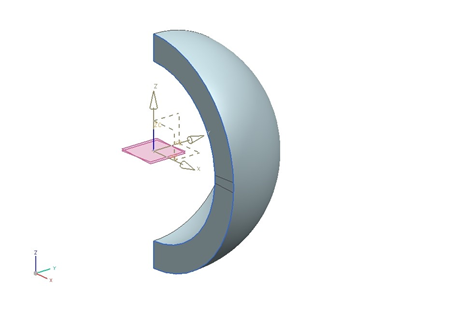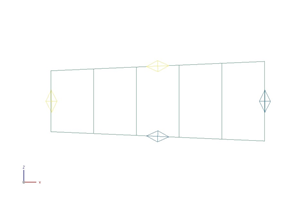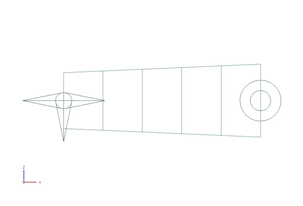VVT7 - Hollow sphere with convective and radiative boundary conditions
| Solution | Test case |
|---|---|
| Finite volume method | SVTEST8 |
| Finite element method | SVTEST234 |
Description
The purpose of this test case is to determine the inner and outer surface temperatures of a hollow sphere which is convecting from its outer surface and radiating from its inner surface.
Geometry
The solid geometry is created by revolving the sketch of half an annulus through an angle of 90 degrees. The inner radius of the annulus is ri = 300 mm, while the outer radius is ro = 392 mm. The result is a quarter hollow sphere. In addition, two datum planes are created by rotating copies of the XY plane ±2.5 degrees about the y-axis. The result is shown in the figure below. The front face of the quarter sphere is subdivided using the subdivide face command and referencing the two datum planes.

Simulation model
This model uses the Axisymmetric Thermal solution type.
The mesh is made of quadrilateral axisymmetric ZX shells using the mesh controls to the edges in order to generate five elements. The following figure shows that the elements are not the same size, but increase with radial distance.

The meshed elements have the following material and physical properties:
- Thermal conductivity: k = 40.0 W/m·°C
- Mass density: arbitrary as this has no bearing on the analysis results.
The following boundary conditions are applied:
- Simple Radiation to Environment constraint on the inner edge of the mesh with an emissivity ϵ= 0.6, view factor = 1, and an ambient temperature Ti,∞ = 500 °C.
- Convection to Environment constraint on the outer edge of the mesh with a heat transfer coefficient ho = 133.5 W/m2·°C and an ambient temperature To,∞ = 20 °C.

The following solution options are set:
- Solution Type = Steady State
- Results Options: Select the conductive heat fluxes at nodes and elements.
The default solver parameters are selected.
Theory
Solving the heat equation expressed in spherical coordinates shows that the temperature within the solid material of the sphere is inversely proportionate to the radial location. The heat flow in the radial direction is constant, and can be expressed in terms of the difference in temperature between the inner and outer surfaces, or in terms of the difference in temperature between the outer surface and the external ambient:
The net heat flow at the inner surface due to the radiative heat exchange has the same value, but is given by the nonlinear Stephen-Boltzmann Law:
The three unknowns, Ti, T0 , and qr are calculated from the presented equations.
Results
The following table compares the nodal temperature results at the inner and outer surfaces, predicted by the thermal solver, with the calculated theoretical results. Simulation results are in agreement with theoretical values.
| Finite volume method | Finite element method | ||||
|---|---|---|---|---|---|
| Parameter | Ttheory (ºC) | Tsim (ºC) | Error (%) | Tsim (ºC) | Error (%) |
| Ti | 91.7 | 90.9 | 0.87 | 91 | 0.76 |
| To | 71.7 | 70.7 | 1.39 | 70.7 | 1.39 |
The table below shows the radial heat transfer rate, qr, obtained from the elemental heat fluxes calculated by the thermal solver using the finite volume method (to three significant digits). It is nearly constant, and is comparable with the theoretical value of qr= 13.2 kW.
| Finite volume method | Finite element method | |||||
|---|---|---|---|---|---|---|
| r (m) | q''r,sim (kW/m2) | qr (kW) | Error (%) | q''r,sim (kW/m2) | qr (kW) | Error(%) |
| 0.308 | 10.89 | 13.0 | 1.20 | 10.88 | 13.04 | 1.20 |
| 0.327 | 9.70 | 13.0 | 1.18 | 9.69 | 13.04 | 1.20 |
| 0.345 | 8.69 | 13.0 | 1.16 | 8.69 | 13.04 | 1.20 |
| 0.364 | 7.83 | 13.1 | 1.14 | 7.83 | 13.04 | 1.20 |
| 0.382 | 7.10 | 13.1 | 1.11 | 7.10 | 13.04 | 1.20 |
Note: This example is fabricated. Realistically, if the inner surface of a hollow sphere radiated energy, the same energy would irradiate the surface. It is a concave surface that sees itself, therefore the view factor, Fjj , would be 1.0. In this example, by specifying an ambient temperature for the inside of the sphere and a view factor of 1.0 between the inner surface and the environment, it implies that there is a black body inside the sphere the same size as the inner surface, and Fjj = 0.
